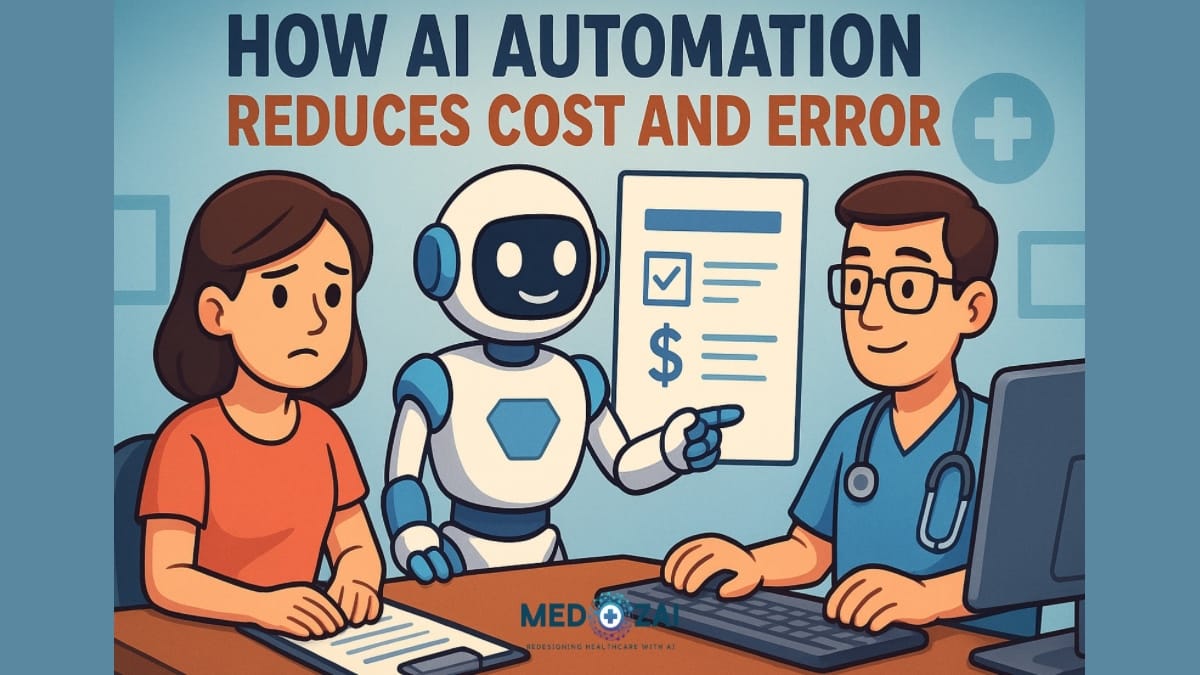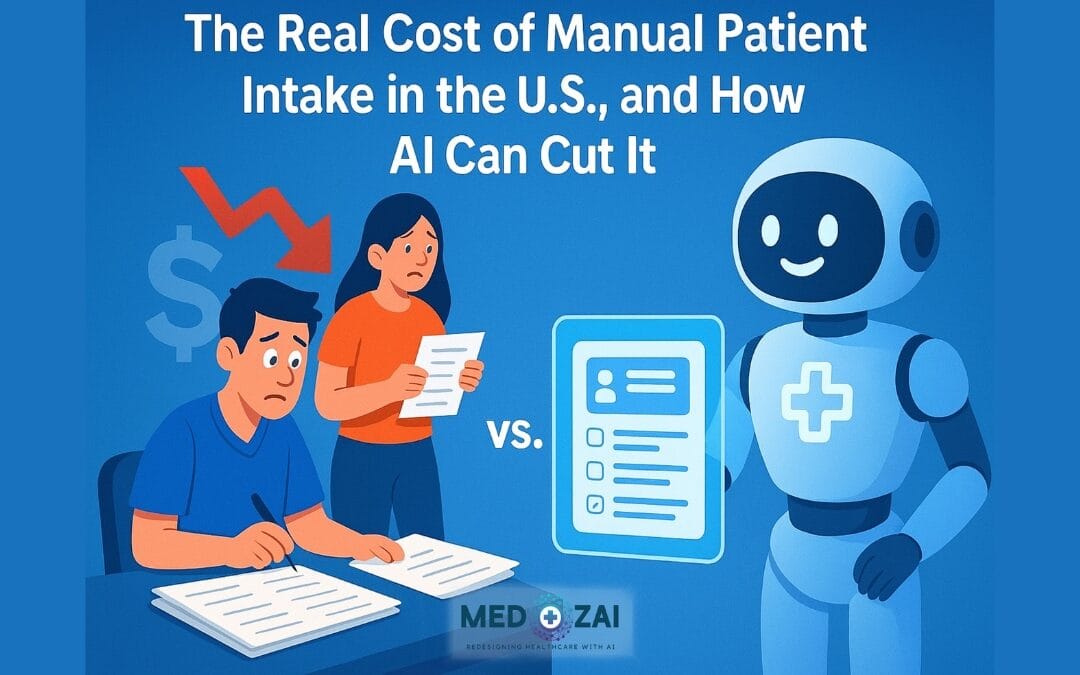Healthcare clinics across the U.S. are under mounting pressure to improve efficiency, reduce overhead, and streamline patient onboarding. Yet manual patient intake remains a hidden cost center—quietly draining resources and slowing down revenue cycles.
Fast Facts: The Hidden Costs of Manual Intake
- U.S. healthcare providers spend about 25% of total healthcare spending on administrative activities—more than twice the rate of countries like Canada (10–15%). (Commonwealth Fund)
- Nearly 20% of healthcare claims are initially denied, and over half are never resubmitted—often due to intake errors like incomplete patient data or insurance mismatches.(JournalOfAhima)
- AI automation reduced documentation time by 40%, saved 15,000+ employee hours monthly, and improved processing accuracy to 99.5% in Omega Healthcare’s implementation. (BusinessInsider)
Introduction
Patient intake—the collection of forms, insurance data, and medical history—is the administrative gateway to healthcare delivery. Yet in many U.S. and Canadian clinics, it remains a manual, paper-heavy process prone to inefficiencies. This article outlines the real cost of manual patient intake and how AI-powered automation can dramatically reduce operational drag, financial waste, and error rates in healthcare settings.
The Real Cost of Manual Patient Intake
1. High Labor and Admin Costs
Manual patient intake workflows in U.S. healthcare are widely recognized as costly and inefficient—but publicly verifiable studies do not quantify a specific per‑patient cost range. What is consistently documented is the large administrative burden and high denial and processing costs stemming from manual workflows:
- U.S. healthcare providers spend approximately 25% of total healthcare spending on administrative activities—far above Canada’s 10–15% benchmark. Cutting U.S. admin spend to peer-country levels could reduce costs by $320–$500 billion annually.
- The average cost to process a single medical claim is $10–$15 for providers, while prior authorization can cost $20–$30 per submission. These are largely labor-driven costs tied to administrative workflow inefficiencies.
- Typical claim denial rates run between 6% and 13%, with administrative errors—often from intake or coding—playing a major role. Reworking each denial can cost between $25 and $117 in staff time and productivity loss.
Rather than relying on unsubstantiated per‑patient intake figures, we highlight documented claims-processing costs, denial-associated expenses, and overall system-level administrative overhead that stem from inefficient intake practices.
Even basic manual processes (e.g., demographic verification, check-in) incur $4–$6 per patient in cost.
For a clinic seeing 100 patients per day, this translates to $1,400–$2,300 daily, or upwards of $500,000 annually—before considering error-related rework.
2. Errors, Delays, and Denials
Manual data entry contributes heavily to downstream administrative burdens:
• Nearly 20% of healthcare claims are initially denied, and up to 60% of these are never resubmitted. One of the leading causes of denials is incorrect or incomplete patient demographic or insurance information—errors often introduced during manual intake. Automating this process improves data accuracy and preserves revenue.
• Practices also spend roughly 3% of annual revenue on paper-based processes—printing, mailing, scanning, and storing forms.
3. Staff Burnout and Turnover
Manual workflows create unsustainable workloads for front-desk staff, with high repetition and stress leading to burnout and frequent turnover—each of which carries recruitment and training costs.
4. Real-Time Documentation Support
Medical documentation can be a major source of burnout for clinicians. Multi-agent systems can listen to patient encounters, transcribe conversations, and auto-fill EMR templates with contextual accuracy.
Agents specialized in compliance can ensure notes meet regulatory standards before they’re finalized, lightening the cognitive load for healthcare providers.
Suggested Reading: What are the cost implications of intake-related errors
How AI Automation Reduces Cost and Error

1. Labor and Time Savings
AI-powered automation platforms are now showing measurable productivity gains:
Omega Healthcare, in partnership with UiPath, reduced documentation time by 40%, saved 15,000 employee hours per month, and improved processing accuracy to 99.5%—delivering a 30% ROI to clients.
2. Fewer Errors, Faster Claims
AI eliminates transcription and data entry errors common in manual workflows. This improves billing accuracy, reduces denials, and shortens revenue cycles.
Practices using AI-driven conversational interfaces and digital intake forms report:
- Lower administrative overhead
- Faster claims processing
- Improved patient satisfaction through smoother onboarding
Why U.S. and Canadian Clinics Should Act Now
With rising operational costs, workforce shortages, and increasing pressure to improve patient access, clinics in both the U.S. and Canada face mounting administrative challenges. Manual intake processes are no longer sustainable in environments that demand speed, accuracy, and scalability.
Now is the time for healthcare organizations to adopt AI-powered solutions that streamline front-office workflows, reduce financial waste, and position their practices for long-term efficiency and growth.
U.S. Practices: High Administrative Overhead
AI-powered automation platforms are now showing measurable productivity gains:
- A 2024 Mirror, Mirror analysis by the Commonwealth Fund placed the U.S. last in administrative efficiency among high-income countries—despite outspending all of them on total healthcare as a share of GDP.
The report attributes much of this inefficiency to fragmented billing, insurance complexity, and redundant intake activities—the very areas AI automation can improve.
Canada: Streamlining Access and Wait Times
Canadian clinics face growing operational pressure from extended wait times and limited staffing capacity. According to the Fraser Institute’s 2024 report, the median wait time from referral by a general practitioner to receipt of medically necessary treatment was 30.0 weeks—the longest ever recorded, and a 222% increase since 1993.
Additionally, nearly 62% of Canadians who needed to see a specialist waited over a month, significantly longer than their peers in the U.S. and U.K. (PMC).
AI-powered intake solutions offer a practical and scalable path forward. By automating routine front-desk tasks, verifying insurance and demographics ahead of appointments, and digitizing consent and medical history collection, these tools help eliminate administrative bottlenecks and accelerate patient flow—freeing clinical teams to focus on direct care.
Frequently Asked Questions (FAQs)
1. How fast can clinics break even on AI intake investments?
Most see ROI within 6–12 months, based on labor savings and reduced claim rework.
2. Can AI tools handle insurance and eligibility checks?
Yes. Many AI platforms integrate with clearinghouses or payer APIs to verify coverage in real time.
3. Is patient data secure with AI-based tools?
Reputable platforms comply with HIPAA, use encryption, and log all data access for auditability.
4. Can AI integrate with existing EHR systems?
Most AI intake tools support FHIR, HL7, and custom APIs for integration with major EHR platforms.
5. Does AI reduce patient satisfaction?
On the contrary, digital intake often improves patient satisfaction by minimizing wait times and errors.
Conclusion:
Manual patient intake is costly, error-prone, and unsustainable for modern clinics—especially in the high-overhead U.S. market. With per-patient costs reaching up to $23 and 61% of claim denials tied to intake errors, the case for automation is clear.
AI-powered solutions offer clinics the ability to reduce overhead, improve accuracy, and accelerate billing cycles—all while enhancing the patient experience. For providers in the U.S. and Canada alike, digitizing intake isn’t just an upgrade—it’s a competitive and financial imperative.
At Medozai, we work with healthcare providers across the U.S. and Canada to automate patient intake and administrative workflows. Our AI-driven solutions are designed to reduce friction, improve data accuracy, and streamline operational efficiency—helping clinics achieve the cost savings and quality improvements outlined in this article.


Trackbacks/Pingbacks